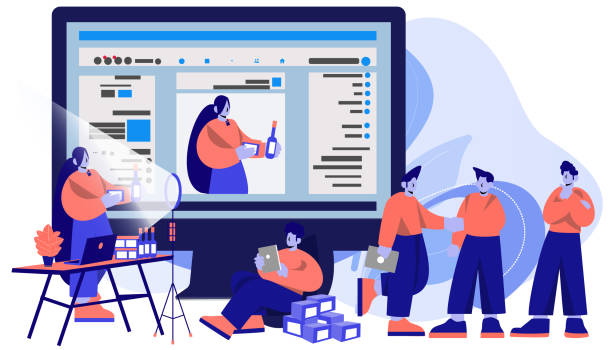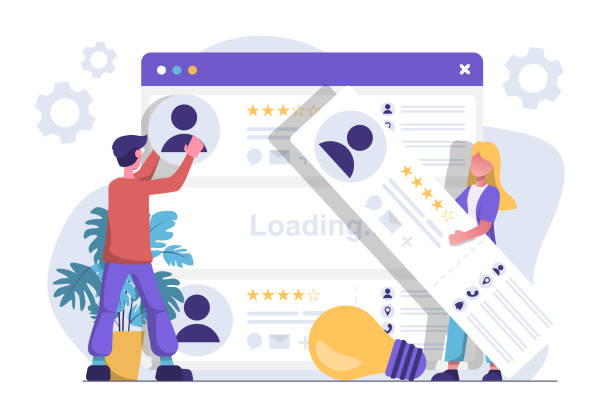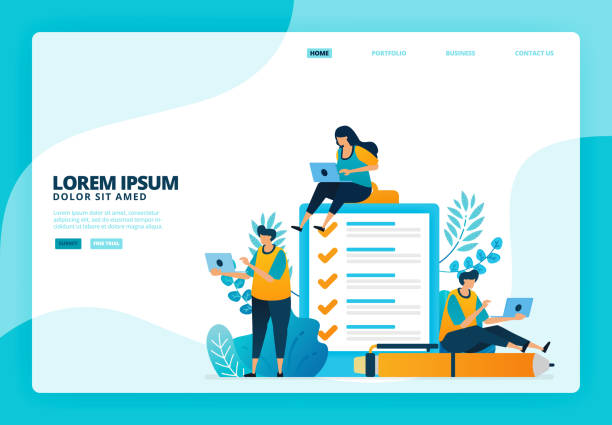The Importance of Responsive Website Design in Today’s World

Today’s #Digital_World changes so rapidly that not keeping pace means falling behind.
Amidst this, Responsive Web Design is no longer a luxury option, but has become an absolute necessity.
With the increasing use of mobile phones and tablets for internet access, having a website that can provide a seamless and optimized user experience on any screen size is crucial.
Statistics show that more than half of global web traffic comes from mobile devices, and this number continues to rise.
Websites designed only for desktop display not only disappoint mobile users but also miss out on countless business and communication opportunities.
Responsive Web Design means building a website that automatically adapts its layout and content to the user’s screen dimensions.
This adaptability includes resizing images, fonts, element arrangement, and navigation to ensure a flawless web browsing experience, whether on a large desktop screen or a small smartphone.
This approach not only leads to increased user satisfaction and a reduced bounce rate, but also offers significant SEO advantages.
Search engines like Google prioritize responsive websites in their search rankings because they provide a better user experience, which is a key factor in ranking algorithms.
Failure to use responsive website design can lead to loss of potential customers, reduced brand credibility, and a drop in search engine rankings.
In an era where users expect access to information anytime, anywhere, your website must be able to provide this access in the best possible way.
This is doubly important for businesses, as the website is often the first point of contact between the customer and the brand, and a poor user experience can mean lost sales.
Therefore, investing in responsive web design is an investment in the future of your business and increased accessibility of your content.
Are you falling behind in the competition with large online stores?
Rasaweb makes your business online with professional e-commerce website design and increases your market share!
✅ Increase brand credibility and customer trust
✅ Easy shopping experience leads to more sales
⚡ Contact us now for a free website design consultation!
Fundamental Principles of Responsive Design

#Responsive_Design is built upon three main pillars, each playing a vital role in creating a flexible user experience.
The first principle is Fluid Grids or Fluid Layouts.
Instead of using fixed pixel units, responsive design utilizes relative units like percentages.
This means that the width of page elements, such as columns and sections, occupies a percentage of their parent’s screen width, rather than having a fixed size.
This approach ensures that the website layout automatically adapts to any screen size, from the smallest smartphone to the largest desktop displays.
The second important principle is Flexible Images or Flexible Media.
Images and other media, such as videos, must also be scalable so that they do not overflow their container or become excessively small.
This is usually achieved by setting the `max-width: 100%` property in CSS for images, which ensures the image never exceeds its container size, but can shrink as needed.
This helps maintain the image’s aspect ratio and prevents layout disruption.
This principle, along with fluid grids, forms the core of a responsive website.
The third and perhaps most important principle is Media Queries.
Media queries are CSS rules that allow the browser to detect user device characteristics (such as screen width, height, orientation, and device type).
Based on these characteristics, specific CSS rules can be applied.
For example, you can define a two-column layout for desktop and a single-column layout for mobile.
This capability allows designers to precisely control how content is displayed on different devices and to provide completely different user experiences for various screen sizes.
It is the combination of these three fundamental principles that has made responsive website design a powerful and flexible method for building modern websites.
Popular Tools and Frameworks in Responsive Design

Today, #web_developers have access to a set of powerful tools and frameworks for building responsive websites, which significantly simplify the design and implementation process.
One of the most well-known and widely used of these frameworks is Bootstrap.
Bootstrap is a CSS, HTML, and JavaScript framework that, by providing a 12-column Grid System, pre-built UI components (such as buttons, forms, navigation bars), and JavaScript plugins, helps developers quickly and easily build responsive and Mobile-First websites.
This framework significantly speeds up development and ensures that your website displays well on various devices.
In addition to Bootstrap, native CSS technologies have also made significant advancements, enabling the implementation of responsive website design without the need for heavy frameworks.
CSS Grid Layout and Flexbox are two powerful CSS3 modules that have revolutionized how web layouts are designed.
Flexbox is highly suitable for arranging elements in one dimension (row or column) and is ideal for distributing space between items in a single-line container.
In contrast, CSS Grid Layout is unparalleled for designing two-dimensional layouts (rows and columns simultaneously) and allows for the creation of more complex and precise structures.
The combination of these two CSS features offers incredible flexibility for implementing responsive layouts and has become the first choice for many developers.
Also, Browser Developer Tools like Inspect Element in Chrome or Firefox are crucial for testing and debugging a responsive website.
These tools allow you to simulate your website on various screen sizes and identify and fix layout-related issues.
Choosing the right tool depends on project needs and developer preferences, but learning the principles of CSS Grid and Flexbox, along with familiarity with frameworks like Bootstrap, provides a comprehensive set of skills for any responsive web designer.
These approaches play a fundamental role in improving the quality and efficiency of standard web design.
| Tool / Framework | Advantages | Disadvantages | Main Use Case |
|---|---|---|---|
| Bootstrap | High development speed, ready-made components, large user community, excellent documentation. | Large file size, generic and recognizable appearance, sometimes extra code. | Quick projects, MVP (Minimum Viable Product), corporate websites. |
| CSS Flexbox | High flexibility in one-dimensional layout, precise control over space distribution, lightweight and native. | Not suitable for complex two-dimensional layouts. | Navigations, cards, footers, elements within a row/column. |
| CSS Grid Layout | Powerful for complex two-dimensional layouts, full control over rows and columns. | Initial learning curve, might be overkill for simpler layouts. | Overall page layout, admin panels, image galleries. |
| Foundation | Powerful and flexible, focus on Semantic HTML, Sass and CLI tools. | Smaller user community than Bootstrap, slightly more complex for beginners. | Large projects, enterprise websites, web applications. |
Impact of Responsive Website Design on User Experience (UX)

#User_Experience (UX) is the core of any website’s success, and responsive website design plays an unparalleled role in improving it.
A properly designed responsive website provides a seamless and enjoyable user experience on any device, from small smartphones to wide desktop monitors.
This means the user doesn’t need to zoom, horizontal scroll, or struggle to find buttons and links on a cluttered page.
Content automatically adjusts, images are optimized, and navigation is easily accessible, all of which means reduced friction and increased user satisfaction.
When users have a good experience on your website, they are more likely to spend more time on it, view more pages, and ultimately convert into customers.
The Bounce Rate significantly decreases because users do not immediately leave the website after entering; instead, they are encouraged to continue browsing by the compatible and usable interface.
Accessibility is another important aspect of UX that is improved by responsive design.
Given that many people use the web with visual or motor impairments, flexible layouts and adjustable fonts help them consume content more easily.
Furthermore, a responsive website ensures faster loading, especially on mobile devices.
This is achieved through image optimization, conditional loading, and providing only the necessary content for each device.
Loading speed is a critical factor in maintaining user attention and directly impacts conversion rates.
Ultimately, responsive website design enhances your brand’s credibility and professionalism.
A website that looks good and functions correctly on all devices demonstrates your attention to detail and commitment to providing the best experience to your audience.
This is highly important not only for existing users but also for attracting new customers and contributes to the overall improvement of web user experience.
Worried about losing customers because you don’t have a professional e-commerce site?
With e-commerce website design by Rasaweb, forget these worries!
✅ Significant increase in sales and visitor-to-customer conversion rate
✅ Professional and user-friendly design that builds customer trust
⚡ Get a free consultation from Rasaweb
SEO Benefits of Responsive Website Design from Google’s Perspective

#SEO and Responsive Web Design are two sides of the same coin for online success, especially since Google explicitly stated that it recommends responsive design as the best approach for building mobile-friendly websites.
One of the most important reasons for this recommendation is Google’s ‘mobile-first indexing’ or mobile-first indexing.
This means that Google primarily uses the mobile version of your website for indexing and ranking.
If your website is not optimized for mobile or provides a poor user experience on smaller devices, your SEO ranking will be severely affected.
With a responsive website, you only have one version of your website that displays correctly across all devices.
This helps Google index and crawl your content more easily, as there’s no need to manage separate desktop and mobile versions.
This uniformity leads to reduced crawl errors and increased crawl efficiency, both of which contribute to better SEO.
Also, a single website makes link management and content sharing easier, as all backlinks point to a single URL, keeping SEO power concentrated.
Furthermore, Page Experience factors, which include loading speed, mobile-friendliness, HTTPS security, and the absence of intrusive pop-ups, have become increasingly important in Google’s ranking algorithm.
A responsive website naturally covers many of these factors: loading speed improves (by optimizing images and content for various devices), mobile compatibility is ensured, and the overall user experience is enhanced, leading to a reduced bounce rate and increased user dwell time on the site.
These factors send positive signals to Google and can lead to better rankings in search results.
Consequently, investing in responsive website design is not only beneficial for your users but also a smart and essential SEO strategy for any business in the current era.
Challenges and Solutions in Responsive Website Design

#Implementing responsive website design, despite its numerous advantages, is not without challenges.
One of the main issues is managing website performance.
While the goal is to provide an optimal experience on all devices, the website might experience slowness on mobile devices with slow internet connections due to loading high-resolution images or heavy CSS and JavaScript files.
The solution to this challenge is image optimization using modern formats (like WebP) and lazy loading techniques, where images are loaded only when they enter the user’s viewport.
Also, compressing CSS and JavaScript code and using Content Delivery Networks (CDNs) can help improve speed.
Another challenge is the complexity of CSS and design logic.
With an increasing number of breakpoints for different screen sizes, managing CSS files can become difficult.
This requires precise CSS structuring and the use of CSS preprocessors like Sass or Less, which provide features such as variables, functions, and nesting for better code organization.
Also, testing and debugging on different devices is another significant challenge.
Given the countless variety of devices and screen sizes, ensuring the website functions correctly on all of them is difficult.
Using browser developer tools, emulators, and testing on actual physical devices is essential.
Furthermore, content management for display on various devices can be complex.
Sometimes, content suitable for desktop appears too long or inappropriate on mobile.
The solution to this problem is the mobile-first approach in design, where it is first designed for the smallest screen, and then content and features are gradually added for larger screens.
This method ensures that the most important content is always accessible.
With careful planning, using appropriate tools, and following best practices, the challenges of responsive website design are manageable, and an excellent user experience can be provided across all devices.
Mobile-First Approach in Responsive Design

#The_Mobile-First_Approach has revolutionized the way of responsive website design and is recognized as a new paradigm in modern web development.
In the past, designers would first build the desktop version of a website and then adapt it for smaller devices using media queries.
This method, known as ‘Desktop-First,’ often led to issues such as slow loading on mobile, excessive content, and inappropriate layouts.
In contrast, the mobile-first approach starts the design and development process from the smallest screen.
This means that initially, you design your website’s layout, content, and functionality for the user experience on mobile devices.
You include only the most essential elements and information at this stage and ensure the website loads quickly and is easy to use.
After that, gradually, using media queries, you expand the layout for larger screen sizes (such as tablets and desktops) and add additional features and content.
This process is often known as ‘Progressive Enhancement’.
The advantages of the mobile-first approach in responsive website design are numerous.
Firstly, due to the focus on essentials for smaller devices, the website will naturally be lighter and faster, which is crucial for SEO and mobile user experience.
Secondly, this approach compels you to carefully consider content importance and prioritize only vital information.
This, in turn, leads to better information architecture and simpler navigation.
Also, given Google’s emphasis on mobile-first indexing, mobile-first design directly helps improve your SEO ranking.
This approach is not only a technical solution but also a mindset shift in how we think about web design, leading to more efficient and user-friendly websites and playing a significant role in improving mobile experience.
| No. | Checklist Item | Details |
|---|---|---|
| 1 | Layout design for small screens | Use of single-column system, large clickable buttons, sufficient white space. |
| 2 | Content prioritization | Displaying only the most essential information first, hiding less important content. |
| 3 | Image and media optimization | Use of responsive images, WebP formats, Lazy Loading. |
| 4 | Performance optimization | Reduce CSS/JS size, compression, use of CDN, use of browser cache. |
| 5 | Testing on real devices | Checking the website on various smartphones and tablets for a real experience. |
| 6 | Simple and accessible navigation | Use of Hamburger Menus or bottom-page menus for mobile. |
The Future of Responsive Website Design and Upcoming Developments

#The_Future_of_Web is constantly evolving, and responsive website design is no exception.
While its basic principles remain constant, new technologies and approaches are emerging that expand the boundaries of what can be achieved with a responsive website.
One of the most important developments is the evolution of CSS towards more powerful and native capabilities.
Features like Container Queries, which allow elements to respond to their parent container’s size rather than the overall viewport, enable more modular and independent design.
This feature brings unprecedented flexibility to responsive design and reduces the need for complex media queries.
Also, Progressive Web Apps (PWAs) will play an increasing role in the future of responsive websites.
PWAs are websites that can offer a user experience similar to native applications, including offline functionality, sending notifications, and installation on the device’s home screen.
This technology has great potential to transform responsive websites into powerful and interactive tools that can bridge the gap between web and native applications.
This combination is particularly useful for increasing user engagement and retention.
Furthermore, the emergence of technologies like Augmented Reality (AR) and Virtual Reality (VR) in the browser creates new challenges for responsive design.
Websites must be able to deliver 3D content and immersive experiences across various devices.
This requires new approaches to design and performance optimization.
AI-powered tools can also assist designers in the future by automating parts of the responsive design process, such as image and layout optimization.
Overall, responsive website design is moving towards becoming smarter, more flexible, and delivering richer and more interactive experiences across all devices, and will be recognized as one of the most important web design trends.
Are you falling behind in the competition with large online stores?
Rasaweb makes your business online with professional e-commerce website design and increases your market share!
✅ Increase brand credibility and customer trust
✅ Easy shopping experience leads to more sales
⚡ Contact us now for a free website design consultation!
Successful Examples of Responsive Website Design and Lessons to Learn

#Reviewing_successful_examples of responsive website design can provide valuable insights for designers and developers.
One prominent example is The Guardian website.
This news site is known for its pioneering approach to responsive design.
With a vast amount of content, The Guardian has succeeded in providing a seamless and readable user experience across various devices.
They have specifically focused on text readability, intuitive navigation, and fast loading of images and videos on mobile, which has made it a model for news sites.
The main lesson from The Guardian is that the first priority should be readability and content accessibility, regardless of screen size.
Another successful example is the Dropbox website, which is a cloud storage platform.
Their website, both on desktop and mobile, is very clean, simple, and functional.
Responsive design in Dropbox ensures that key elements like login forms and calls to action are always prominent and accessible.
This site demonstrates how a responsive website design can effectively focus on business goals while providing a pleasant and efficient visual experience.
This case shows that simplicity and focus on core tasks can be very powerful in responsive design.
The Adidas company website is also an excellent example of responsive website design in the e-commerce sector.
With an extensive product catalog, Adidas has made the online shopping experience smooth and engaging on any device.
This site effectively uses responsive images and adjustable product galleries and has also simplified the checkout process on mobile.
The key lesson from Adidas is that the shopping experience and checkout process must be prioritized, as these directly impact conversion rates.
These examples show how, by focusing on user needs and business goals, one can achieve a successful responsive design that is both aesthetically pleasing and performs excellently.
Why You Should Embrace Responsive Design Today?

#Immediate_Action in responsive website design is no longer a recommendation, but a strategic necessity for any business or individual operating in the online space.
Given the growing statistics of mobile device usage for internet access, ignoring your website’s compatibility with these devices means losing a significant portion of potential and existing audiences.
A website that doesn’t display well on mobile not only drives users away but also harms your brand’s credibility.
In contrast, a responsive website demonstrates your professionalism and customer-centric approach.
Beyond user experience, the SEO benefits of responsive website design alone are a sufficient reason to migrate to this approach.
With Google’s ‘mobile-first indexing’ approach, websites optimized for mobile achieve better rankings in search results.
This means increased visibility, increased organic traffic, and ultimately, more opportunities to attract customers.
Also, managing a single website, instead of multiple separate versions for desktop and mobile, simplifies development and maintenance processes and reduces costs.
Finally, responsive website design prepares you for the future.
With the emergence of new devices and screen sizes, a responsive website will automatically be able to adapt, without the need for a complete redesign.
This approach ensures the sustainability and longevity of your website in the long run.
If your website is not yet responsive, it’s time to consider this change as a top priority.
This investment not only improves user experience and strengthens your SEO but also significantly increases your business’s potential for growth and success in the digital space and acts as a comprehensive SEO strategy.
Frequently Asked Questions
| Question | Answer |
|---|---|
| What is responsive website design? | It is a web design approach aiming to create websites that can automatically adapt to the user’s screen size and device (computer, tablet, mobile) and provide the best user experience. |
| Why is responsive design important? | Its importance has increased due to the growing variety of devices people use to access the internet. This design improves user experience, boosts search engine rankings (SEO), and reduces maintenance costs. |
| How is responsive design implemented? | By using CSS techniques such as Media Queries (which allow you to change styles based on device characteristics like screen width), Fluid Grids, and Flexible Images. |
| What are the key principles of responsive design? | The three main principles are: Fluid Grids (using relative units like percentages instead of pixels for widths), Flexible Images (adapting image sizes to available space), and Media Queries (applying different styles based on screen characteristics). |
| What are the benefits of having a responsive website? | Providing a consistent user experience across all devices, improved SEO, increased user dwell time on the site, reduced bounce rate, easier site management and updates (only one codebase). |
And other services of Rasaweb Advertising Agency in the field of advertising
Smart Conversion Rate Optimization: A specialized service for growing user engagement based on Google Ads management.
Smart Custom Software: Transform user engagement with precise audience targeting.
Smart Marketing Automation: A professional solution to increase website traffic by focusing on user experience customization.
Smart Direct Marketing: A blend of creativity and technology to attract customers through SEO-driven content strategy.
Smart Direct Marketing: Revolutionize click-through rates with appealing UI design.
And over hundreds of other services in internet advertising, advertising consultation, and organizational solutions
Internet Advertising | Advertising Strategy | Advertorial
References
What is responsive website design and why is it important?
What is responsive design?
Responsive Design Tutorial
What is responsive website design?
Do you dream of your business being seen in the online world? Rasaweb Afarin Digital Marketing Agency, by providing innovative and comprehensive solutions, from custom website design and professional optimization to managing advertising campaigns, elevates you to the top. Build your digital future with us.
📍 Tehran, Mirdamad Street, next to Bank Markazi, Kazeroun Jonoubi Alley, Ramin Alley No. 6



